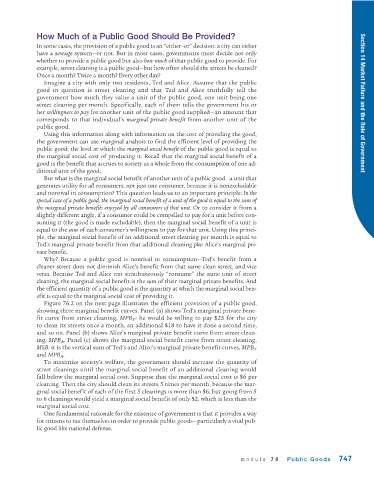Page 789 - Krugmans Economics for AP Text Book_Neat
P. 789
How Much of a Public Good Should Be Provided?
In some cases, the provision of a public good is an “either–or” decision: a city can either
have a sewage system—or not. But in most cases, governments must decide not only
whether to provide a public good but also how much of that public good to provide. For
example, street cleaning is a public good—but how often should the streets be cleaned?
Once a month? Twice a month? Every other day?
Imagine a city with only two residents, Ted and Alice. Assume that the public
good in question is street cleaning and that Ted and Alice truthfully tell the
government how much they value a unit of the public good, one unit being one
street cleaning per month. Specifically, each of them tells the government his or Section 14 Market Failure and the Role of Government
her willingness to pay for another unit of the public good supplied—an amount that
corresponds to that individual’s marginal private benefit from another unit of the
public good.
Using this information along with information on the cost of providing the good,
the government can use marginal analysis to find the efficient level of providing the
public good: the level at which the marginal social benefit of the public good is equal to
the marginal social cost of producing it. Recall that the marginal social benefit of a
good is the benefit that accrues to society as a whole from the consumption of one ad-
ditional unit of the good.
But what is the marginal social benefit of another unit of a public good—a unit that
generates utility for all consumers, not just one consumer, because it is nonexcludable
and nonrival in consumption? This question leads us to an important principle: In the
special case of a public good, the marginal social benefit of a unit of the good is equal to the sum of
the marginal private benefits enjoyed by all consumers of that unit. Or to consider it from a
slightly different angle, if a consumer could be compelled to pay for a unit before con-
suming it (the good is made excludable), then the marginal social benefit of a unit is
equal to the sum of each consumer’s willingness to pay for that unit. Using this princi-
ple, the marginal social benefit of an additional street cleaning per month is equal to
Ted’s marginal private benefit from that additional cleaning plus Alice’s marginal pri-
vate benefit.
Why? Because a public good is nonrival in consumption—Ted’s benefit from a
cleaner street does not diminish Alice’s benefit from that same clean street, and vice
versa. Because Ted and Alice can simultaneously “consume” the same unit of street
cleaning, the marginal social benefit is the sum of their marginal private benefits. And
the efficient quantity of a public good is the quantity at which the marginal social ben-
efit is equal to the marginal social cost of providing it.
Figure 76.2 on the next page illustrates the efficient provision of a public good,
showing three marginal benefit curves. Panel (a) shows Ted’s marginal private bene-
fit curve from street cleaning, MPB T : he would be willing to pay $25 for the city
to clean its streets once a month, an additional $18 to have it done a second time,
and so on. Panel (b) shows Alice’s marginal private benefit curve from street clean-
ing, MPB A . Panel (c) shows the marginal social benefit curve from street cleaning,
MSB: it is the vertical sum of Ted’s and Alice’s marginal private benefit curves, MPB T
and MPB A .
To maximize society’s welfare, the government should increase the quantity of
street cleanings until the marginal social benefit of an additional cleaning would
fall below the marginal social cost. Suppose that the marginal social cost is $6 per
cleaning. Then the city should clean its streets 5 times per month, because the mar-
ginal social benefit of each of the first 5 cleanings is more than $6, but going from 5
to 6 cleanings would yield a marginal social benefit of only $2, which is less than the
marginal social cost.
One fundamental rationale for the existence of government is that it provides a way
for citizens to tax themselves in order to provide public goods—particularly a vital pub-
lic good like national defense.
module 76 Public Goods 747

